FIAT 500 ABARTH 2013 2.G Owner's Manual
Manufacturer: FIAT, Model Year: 2013, Model line: 500 ABARTH, Model: FIAT 500 ABARTH 2013 2.GPages: 84, PDF Size: 4.63 MB
Page 11 of 84
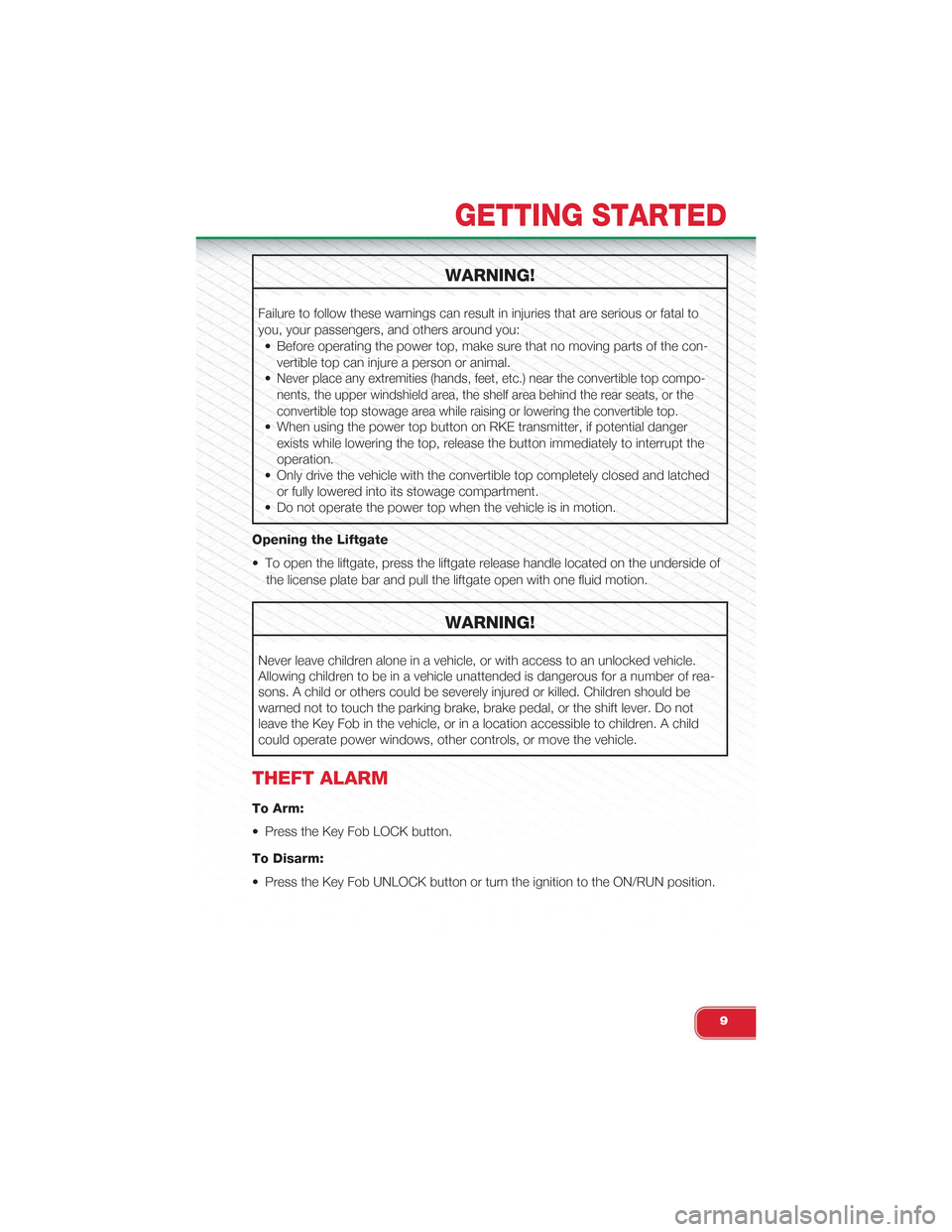
WARNING!
Failure to follow these warnings can result in injuries that are serious or fatal to
you, your passengers, and others around you:
• Before operating the power top, make sure that no moving parts of the con-
vertible top can injure a person or animal.
•Never place any extremities (hands, feet, etc.) near the convertible top compo-
nents, the upper windshield area, the shelf area behind the rear seats, or the
convertible top stowage area while raising or lowering the convertible top.
• When using the power top button on RKE transmitter, if potential danger
exists while lowering the top, release the button immediately to interrupt the
operation.
• Only drive the vehicle with the convertible top completely closed and latched
or fully lowered into its stowage compartment.
• Do not operate the power top when the vehicle is in motion.
Opening the Liftgate
• To open the liftgate, press the liftgate release handle located on the underside of
the license plate bar and pull the liftgate open with one fluid motion.
WARNING!
Never leave children alone in a vehicle, or with access to an unlocked vehicle.
Allowing children to be in a vehicle unattended is dangerous for a number of rea-
sons. A child or others could be severely injured or killed. Children should be
warned not to touch the parking brake, brake pedal, or the shift lever. Do not
leave the Key Fob in the vehicle, or in a location accessible to children. A child
could operate power windows, other controls, or move the vehicle.
THEFT ALARM
To Arm:
• Press the Key Fob LOCK button.
To Disarm:
• Press the Key Fob UNLOCK button or turn the ignition to the ON/RUN position.
GETTING STARTED
9
Page 12 of 84
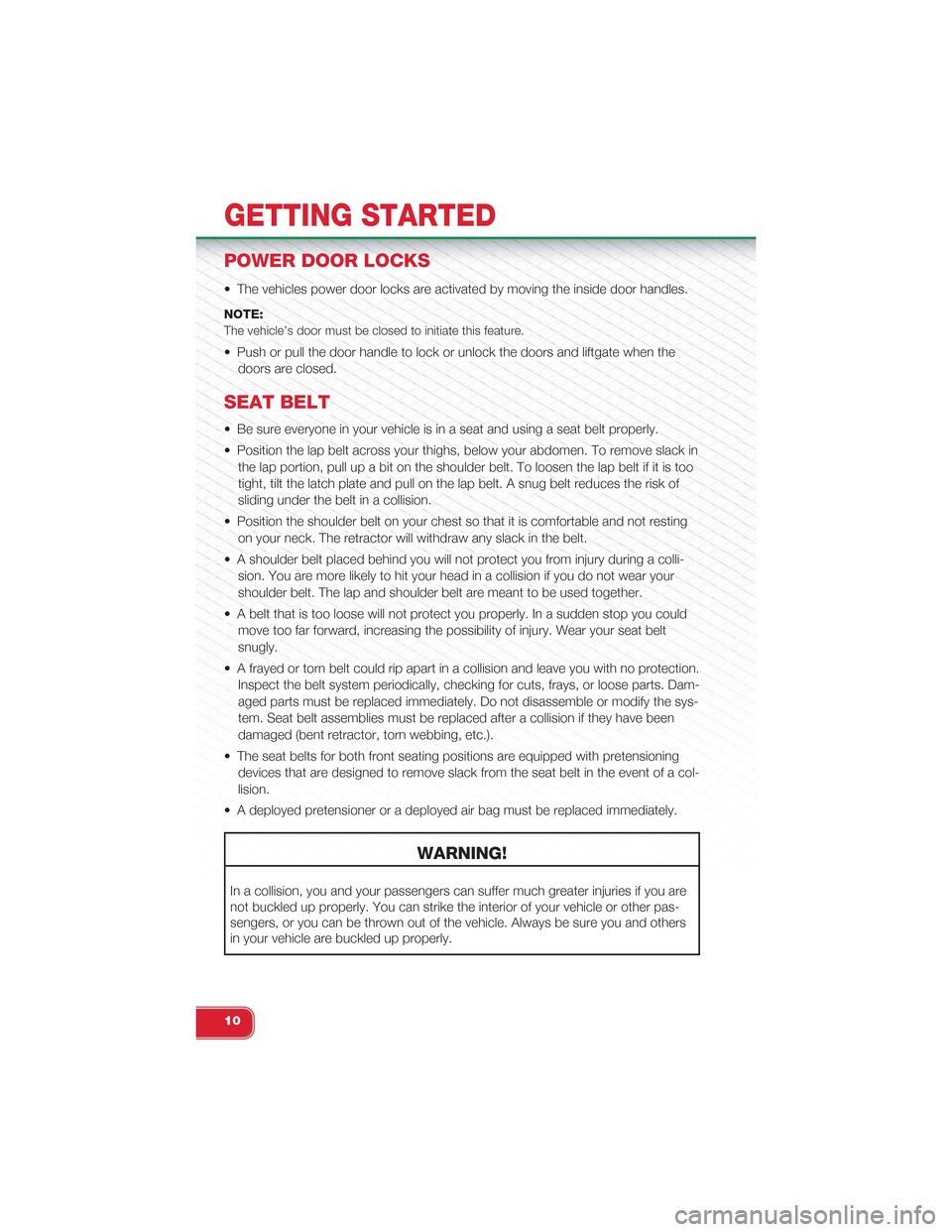
POWER DOOR LOCKS
• The vehicles power door locks are activated by moving the inside door handles.
NOTE:
The vehicle’s door must be closed to initiate this feature.
• Push or pull the door handle to lock or unlock the doors and liftgate when the
doors are closed.
SEAT BELT
• Be sure everyone in your vehicle is in a seat and using a seat belt properly.
• Position the lap belt across your thighs, below your abdomen. To remove slack in
the lap portion, pull up a bit on the shoulder belt. To loosen the lap belt if it is too
tight, tilt the latch plate and pull on the lap belt. A snug belt reduces the risk of
sliding under the belt in a collision.
• Position the shoulder belt on your chest so that it is comfortable and not resting
on your neck. The retractor will withdraw any slack in the belt.
• A shoulder belt placed behind you will not protect you from injury during a colli-
sion. You are more likely to hit your head in a collision if you do not wear your
shoulder belt. The lap and shoulder belt are meant to be used together.
• A belt that is too loose will not protect you properly. In a sudden stop you could
move too far forward, increasing the possibility of injury. Wear your seat belt
snugly.
• A frayed or torn belt could rip apart in a collision and leave you with no protection.
Inspect the belt system periodically, checking for cuts, frays, or loose parts. Dam-
aged parts must be replaced immediately. Do not disassemble or modify the sys-
tem. Seat belt assemblies must be replaced after a collision if they have been
damaged (bent retractor, torn webbing, etc.).
• The seat belts for both front seating positions are equipped with pretensioning
devices that are designed to remove slack from the seat belt in the event of a col-
lision.
• A deployed pretensioner or a deployed air bag must be replaced immediately.
WARNING!
In a collision, you and your passengers can suffer much greater injuries if you are
not buckled up properly. You can strike the interior of your vehicle or other pas-
sengers, or you can be thrown out of the vehicle. Always be sure you and others
in your vehicle are buckled up properly.
GETTING STARTED
10
Page 13 of 84

SUPPLEMENTAL RESTRAINT SYSTEM (SRS) -
AIR BAGS
• This vehicle has Advanced Front Air Bags for both the driver and right front pas-
senger as a supplement to the seat belt restraint system. The Advanced Front Air
Bags will not deploy in every type of collision.
• Advanced Front Air Bags are designed to provide additional protection by supple-
menting the seat belts in certain frontal collisions depending on several factors,
including the severity and type of collision. Advanced Front Air Bags are not ex-
pected to reduce the risk of injury in rear, side, or rollover collisions.
• This vehicle is equipped with Supplemental Side Air Bag Inflatable Curtains to
protect the driver, front and rear passengers sitting next to a window.
• This vehicle is equipped with Supplemental Seat-Mounted Side Air Bags to pro-
vide enhanced protection to help protect an occupant during a side impact.
• This vehicle is equipped with Supplemental Driver Side Knee Air Bag to provide
enhanced protection and work together with the Driver Advanced Front Air Bag
during a frontal impact.
• If the Air Bag Warning Lightis not on during starting, stays on, or turns on
while driving, have the vehicle serviced by an authorized studio immediately.
• Refer to the Owner's Manual on the DVD for further details regarding the Supple-
mental Restraint System (SRS).
WARNING!
• Relying on the air bags alone could lead to more severe injuries in a collision.
The air bags work with your seat belt to restrain you properly. In some colli-
sions, the air bags won't deploy at all. Always wear your seat belts even
though you have air bags.
• Being too close to the steering wheel or instrument panel during Advanced
Front Air Bag deployment could cause serious injury, including death. Air
bags need room to inflate. Sit back, comfortably extending your arms to
reach the steering wheel or instrument panel.
• Supplemental Side Air Bag Inflatable Curtains and Supplemental Seat-
Mounted Side Air Bags need room to inflate. Do not lean against the door or
window. Sit upright in the center of the seat.
• Being too close to the Supplemental Side Air Bag Inflatable Curtain and/or
Seat-Mounted Side Air Bag during deployment could cause you to be se-
verely injured or killed.
• Do not drive your vehicle after the air bags have deployed. If you are involved
in another collision, the air bags will not be in place to protect you.
• After any collision, the vehicle should be taken to an authorized studio imme-
diately.
GETTING STARTED
11
Page 14 of 84

CHILD RESTRAINTS
• Children 12 years and under should ride properly buckled up in a rear seat, if
available. According to crash statistics, children are safer when properly re-
strained in the rear seats rather than in the front.
• Every state in the United States and every Canadian province requires that small
children ride in proper restraint systems. This is the law, and you can be pros-
ecuted for ignoring it.
Installing The LATCH - Compatible Child Restraint System
• Your vehicle's second row passenger seats are equipped with the child restraint
anchorage system called LATCH, which stands for Lower Anchors and Tethers
for CHildren. LATCH child restraint anchorage systems are installed in both rear
seating positions.
• The LATCH lower anchorages are round bars, located at the rear of the seat
cushion where it meets the seatback. They can be readily identified by the sym-
bol located on the seatback directly above the anchorages and are just visible
when you lean into the rear seat to install the child restraint.
• In addition, there are tether strap anchorages behind each rear seating position
located on the back of the seat.
•NEVERuse the same lower anchorage to attach more than one child restraint.
• Loosen the child seat adjusters on the
lower straps and tether straps so that
you can attach the hook or connector
to the anchors.
• Attach the lower hooks or connectors
over the top of the anchorage bars,
pushing aside the seat cover material.
• Pass the tether strap under the center of the head restraint and attach it to the
top tether anchor on the rear of the seatback.
• Tighten all three straps as you push
the child restraint rearward and down-
ward into the seat. Remove slack in
the straps according to the child re-
straint manufacturer’s instructions.
GETTING STARTED
12
Page 15 of 84
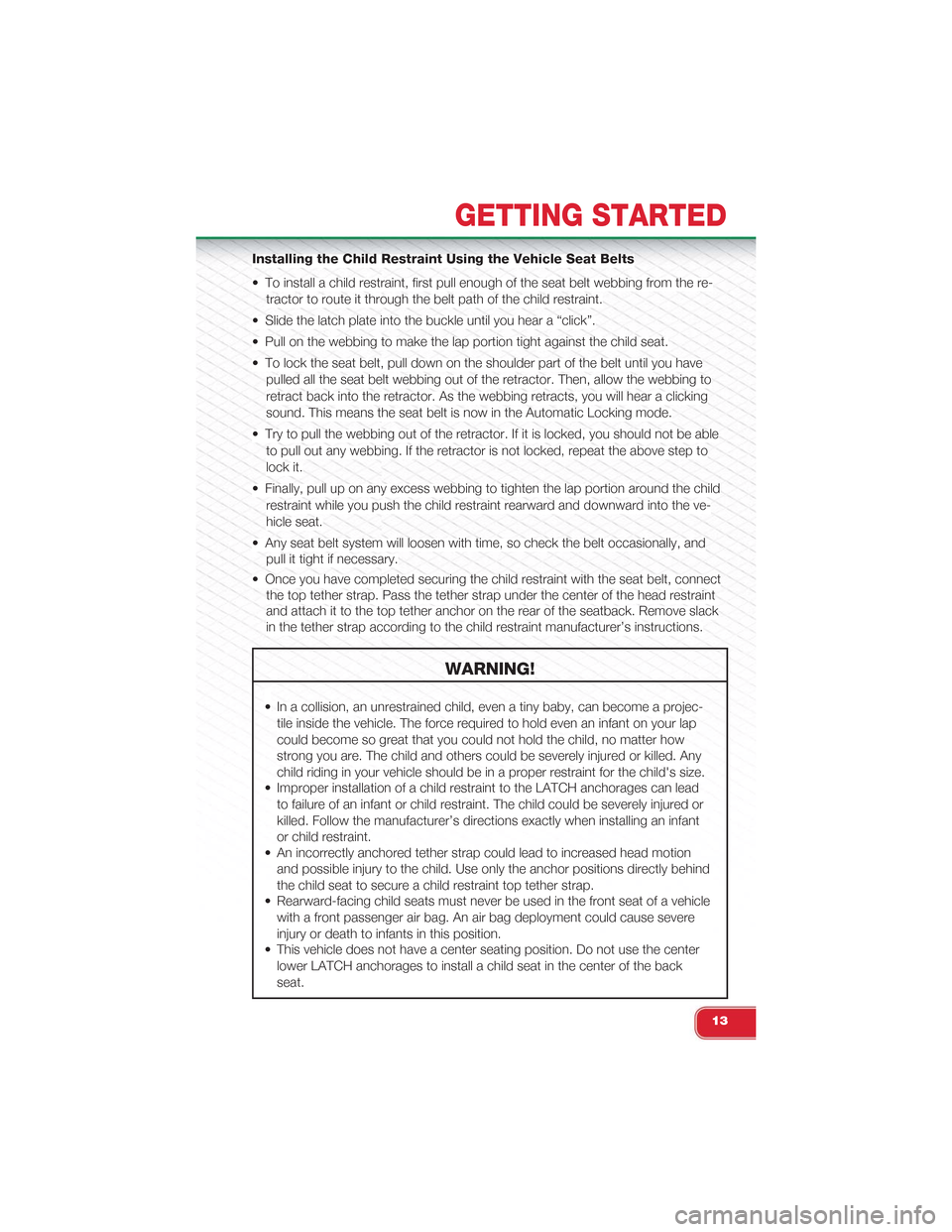
Installing the Child Restraint Using the Vehicle Seat Belts
• To install a child restraint, first pull enough of the seat belt webbing from the re-
tractor to route it through the belt path of the child restraint.
• Slide the latch plate into the buckle until you hear a “click”.
• Pull on the webbing to make the lap portion tight against the child seat.
• To lock the seat belt, pull down on the shoulder part of the belt until you have
pulled all the seat belt webbing out of the retractor. Then, allow the webbing to
retract back into the retractor. As the webbing retracts, you will hear a clicking
sound. This means the seat belt is now in the Automatic Locking mode.
• Try to pull the webbing out of the retractor. If it is locked, you should not be able
to pull out any webbing. If the retractor is not locked, repeat the above step to
lock it.
• Finally, pull up on any excess webbing to tighten the lap portion around the child
restraint while you push the child restraint rearward and downward into the ve-
hicle seat.
• Any seat belt system will loosen with time, so check the belt occasionally, and
pull it tight if necessary.
• Once you have completed securing the child restraint with the seat belt, connect
the top tether strap. Pass the tether strap under the center of the head restraint
and attach it to the top tether anchor on the rear of the seatback. Remove slack
in the tether strap according to the child restraint manufacturer’s instructions.
WARNING!
• In a collision, an unrestrained child, even a tiny baby, can become a projec-
tile inside the vehicle. The force required to hold even an infant on your lap
could become so great that you could not hold the child, no matter how
strong you are. The child and others could be severely injured or killed. Any
child riding in your vehicle should be in a proper restraint for the child's size.
• Improper installation of a child restraint to the LATCH anchorages can lead
to failure of an infant or child restraint. The child could be severely injured or
killed. Follow the manufacturer’s directions exactly when installing an infant
or child restraint.
• An incorrectly anchored tether strap could lead to increased head motion
and possible injury to the child. Use only the anchor positions directly behind
the child seat to secure a child restraint top tether strap.
• Rearward-facing child seats must never be used in the front seat of a vehicle
with a front passenger air bag. An air bag deployment could cause severe
injury or death to infants in this position.
• This vehicle does not have a center seating position. Do not use the center
lower LATCH anchorages to install a child seat in the center of the back
seat.
GETTING STARTED
13
Page 16 of 84
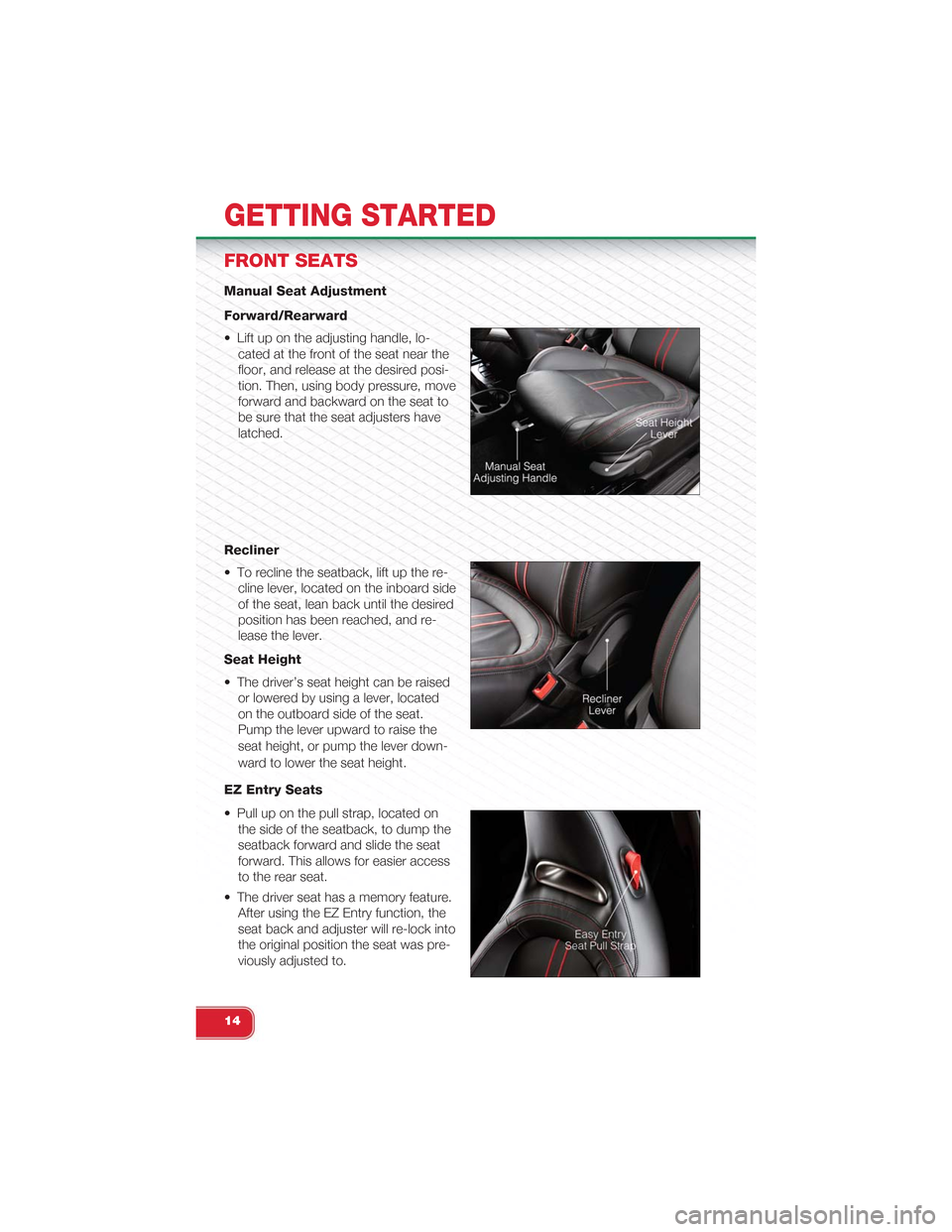
FRONT SEATS
Manual Seat Adjustment
Forward/Rearward
• Lift up on the adjusting handle, lo-
cated at the front of the seat near the
floor, and release at the desired posi-
tion. Then, using body pressure, move
forward and backward on the seat to
be sure that the seat adjusters have
latched.
Recliner
• To recline the seatback, lift up the re-
cline lever, located on the inboard side
of the seat, lean back until the desired
position has been reached, and re-
lease the lever.
Seat Height
• The driver’s seat height can be raised
or lowered by using a lever, located
on the outboard side of the seat.
Pump the lever upward to raise the
seat height, or pump the lever down-
ward to lower the seat height.
EZ Entry Seats
• Pull up on the pull strap, located on
the side of the seatback, to dump the
seatback forward and slide the seat
forward. This allows for easier access
to the rear seat.
• The driver seat has a memory feature.
After using the EZ Entry function, the
seat back and adjuster will re-lock into
the original position the seat was pre-
viously adjusted to.
GETTING STARTED
14
Page 17 of 84
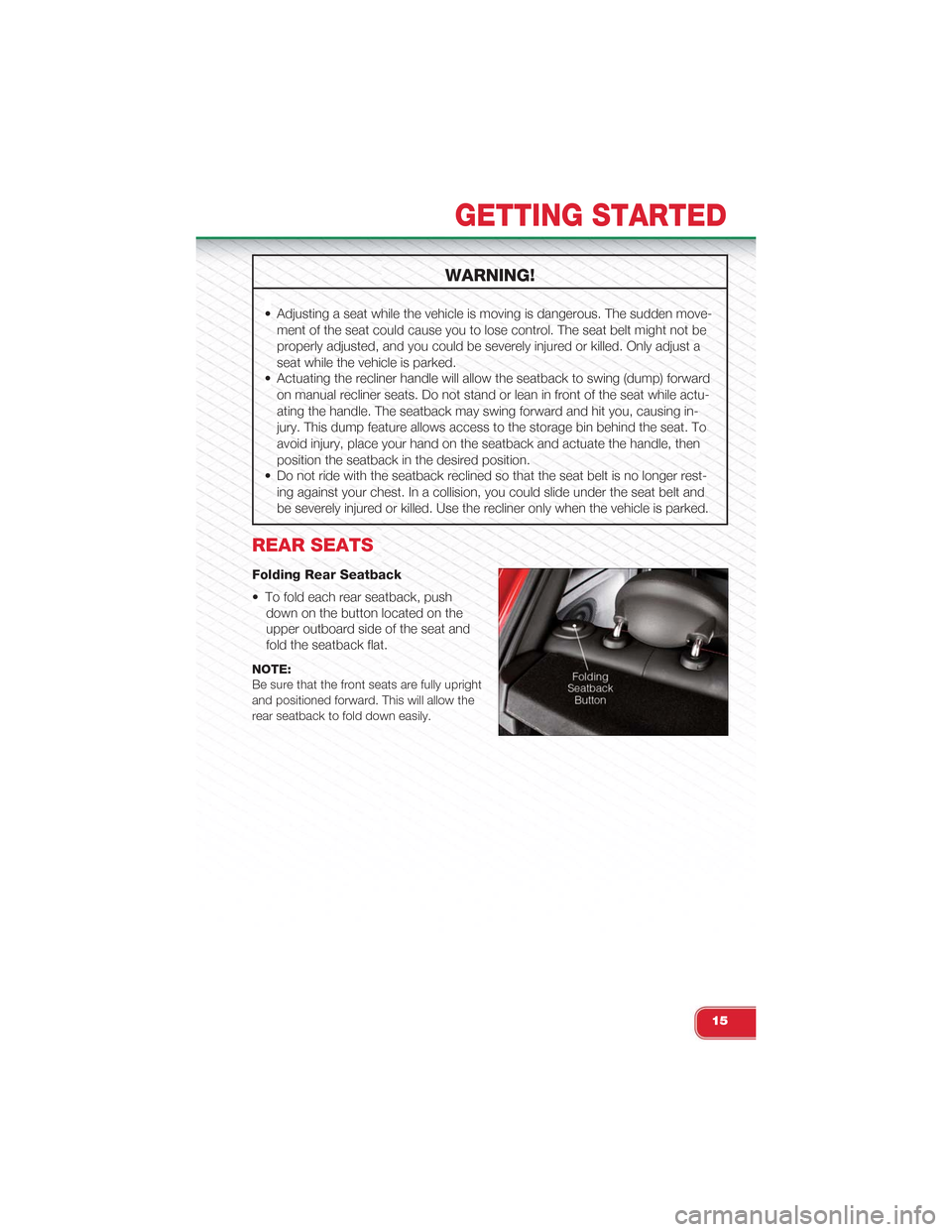
WARNING!
• Adjusting a seat while the vehicle is moving is dangerous. The sudden move-
ment of the seat could cause you to lose control. The seat belt might not be
properly adjusted, and you could be severely injured or killed. Only adjust a
seat while the vehicle is parked.
• Actuating the recliner handle will allow the seatback to swing (dump) forward
on manual recliner seats. Do not stand or lean in front of the seat while actu-
ating the handle. The seatback may swing forward and hit you, causing in-
jury. This dump feature allows access to the storage bin behind the seat. To
avoid injury, place your hand on the seatback and actuate the handle, then
position the seatback in the desired position.
• Do not ride with the seatback reclined so that the seat belt is no longer rest-
ing against your chest. In a collision, you could slide under the seat belt and
be severely injured or killed. Use the recliner only when the vehicle is parked.
REAR SEATS
Folding Rear Seatback
• To fold each rear seatback, push
down on the button located on the
upper outboard side of the seat and
fold the seatback flat.
NOTE:Be sure that the front seats are fully uprightand positioned forward. This will allow therear seatback to fold down easily.
GETTING STARTED
15
Page 18 of 84
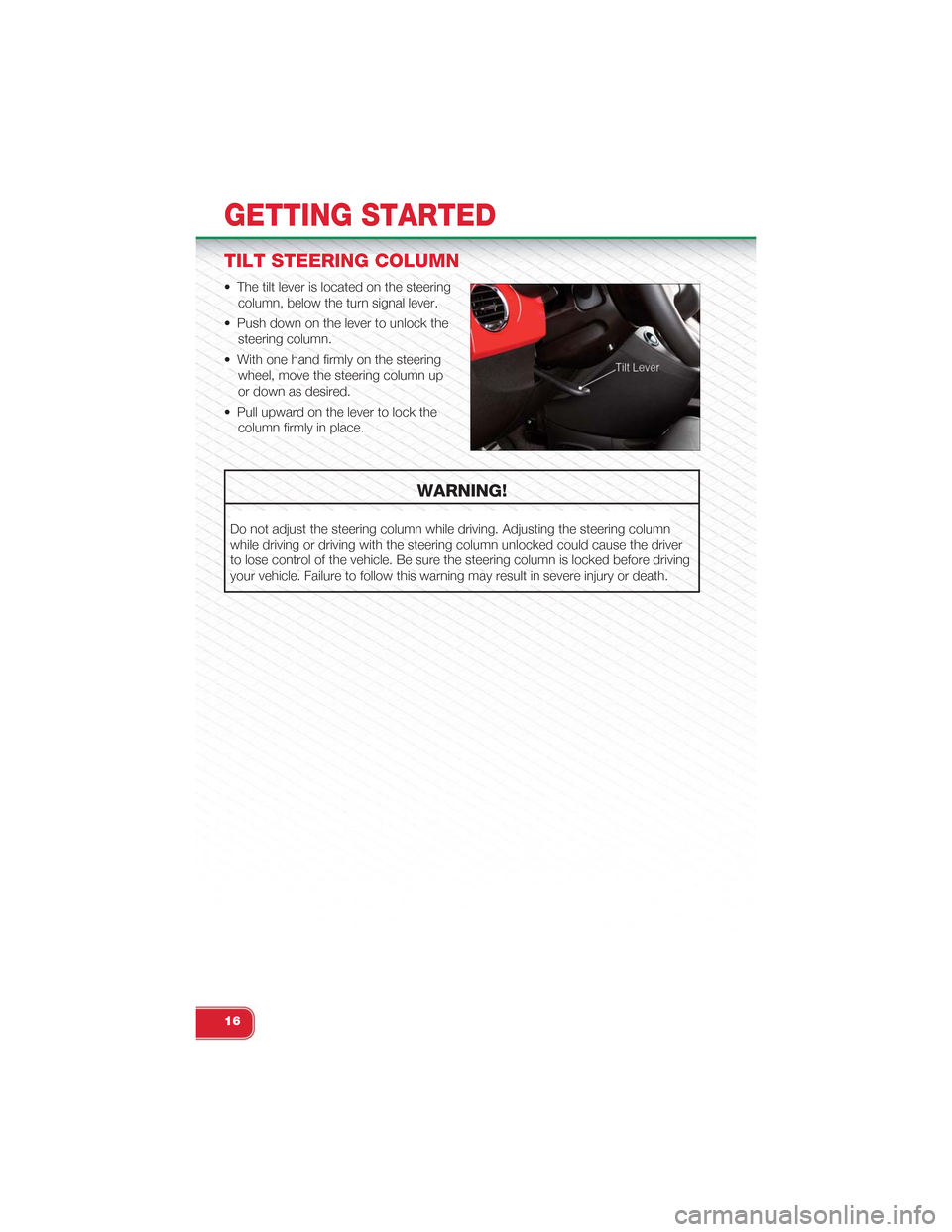
TILT STEERING COLUMN
• The tilt lever is located on the steering
column, below the turn signal lever.
• Push down on the lever to unlock the
steering column.
• With one hand firmly on the steering
wheel, move the steering column up
or down as desired.
• Pull upward on the lever to lock the
column firmly in place.
WARNING!
Do not adjust the steering column while driving. Adjusting the steering column
while driving or driving with the steering column unlocked could cause the driver
to lose control of the vehicle. Be sure the steering column is locked before driving
your vehicle. Failure to follow this warning may result in severe injury or death.
GETTING STARTED
16
Page 19 of 84
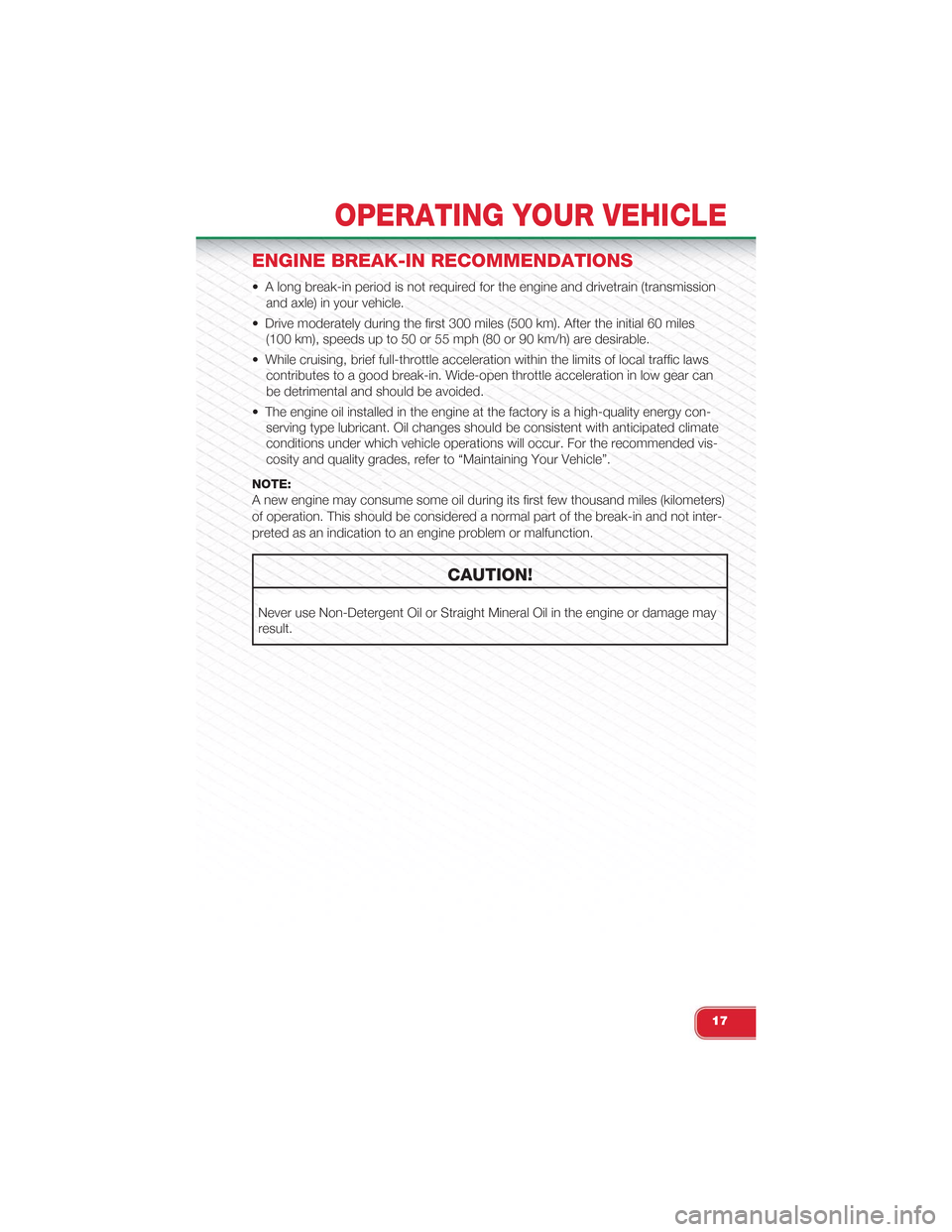
ENGINE BREAK-IN RECOMMENDATIONS
• A long break-in period is not required for the engine and drivetrain (transmission
and axle) in your vehicle.
• Drive moderately during the first 300 miles (500 km). After the initial 60 miles
(100 km), speeds up to 50 or 55 mph (80 or 90 km/h) are desirable.
• While cruising, brief full-throttle acceleration within the limits of local traffic laws
contributes to a good break-in. Wide-open throttle acceleration in low gear can
be detrimental and should be avoided.
• The engine oil installed in the engine at the factory is a high-quality energy con-
serving type lubricant. Oil changes should be consistent with anticipated climate
conditions under which vehicle operations will occur. For the recommended vis-
cosity and quality grades, refer to “Maintaining Your Vehicle”.
NOTE:
A new engine may consume some oil during its first few thousand miles (kilometers)
of operation. This should be considered a normal part of the break-in and not inter-
preted as an indication to an engine problem or malfunction.
CAUTION!
Never use Non-Detergent Oil or Straight Mineral Oil in the engine or damage may
result.
OPERATING YOUR VEHICLE
17
Page 20 of 84
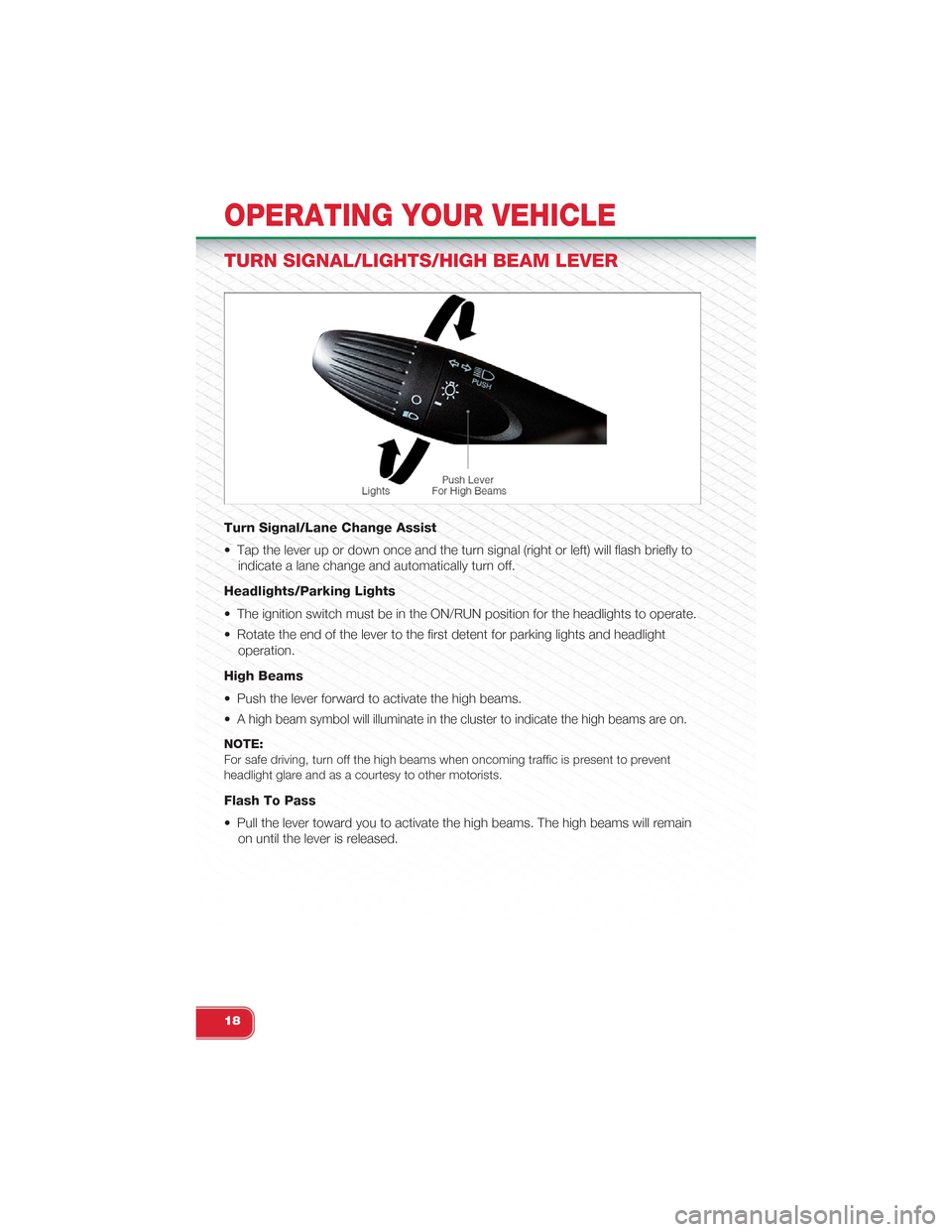
TURN SIGNAL/LIGHTS/HIGH BEAM LEVER
Turn Signal/Lane Change Assist
• Tap the lever up or down once and the turn signal (right or left) will flash briefly to
indicate a lane change and automatically turn off.
Headlights/Parking Lights
• The ignition switch must be in the ON/RUN position for the headlights to operate.
• Rotate the end of the lever to the first detent for parking lights and headlight
operation.
High Beams
• Push the lever forward to activate the high beams.
•A high beam symbol will illuminate in the cluster to indicate the high beams are on.
NOTE:For safe driving, turn off the high beams when oncoming traffic is present to preventheadlight glare and as a courtesy to other motorists.
Flash To Pass
• Pull the lever toward you to activate the high beams. The high beams will remain
on until the lever is released.
OPERATING YOUR VEHICLE
18